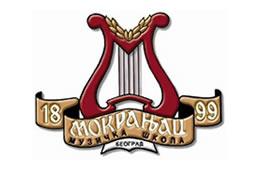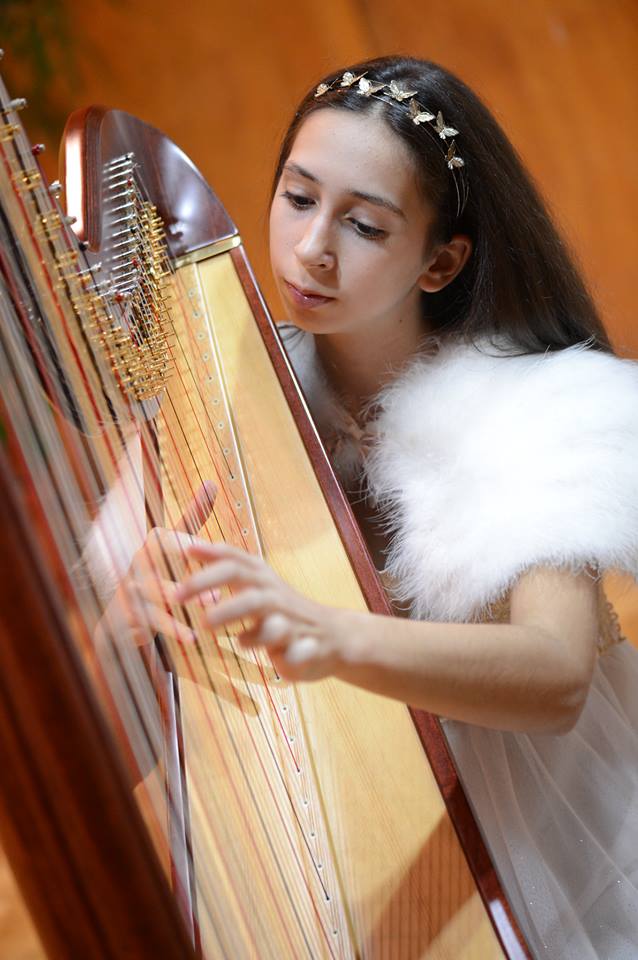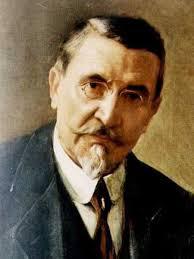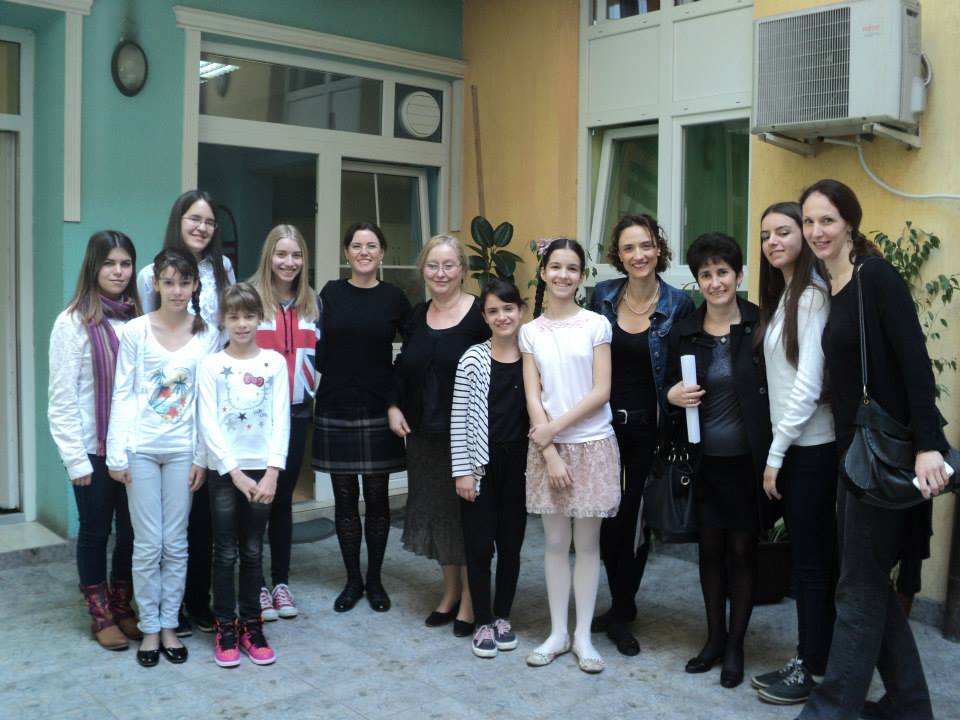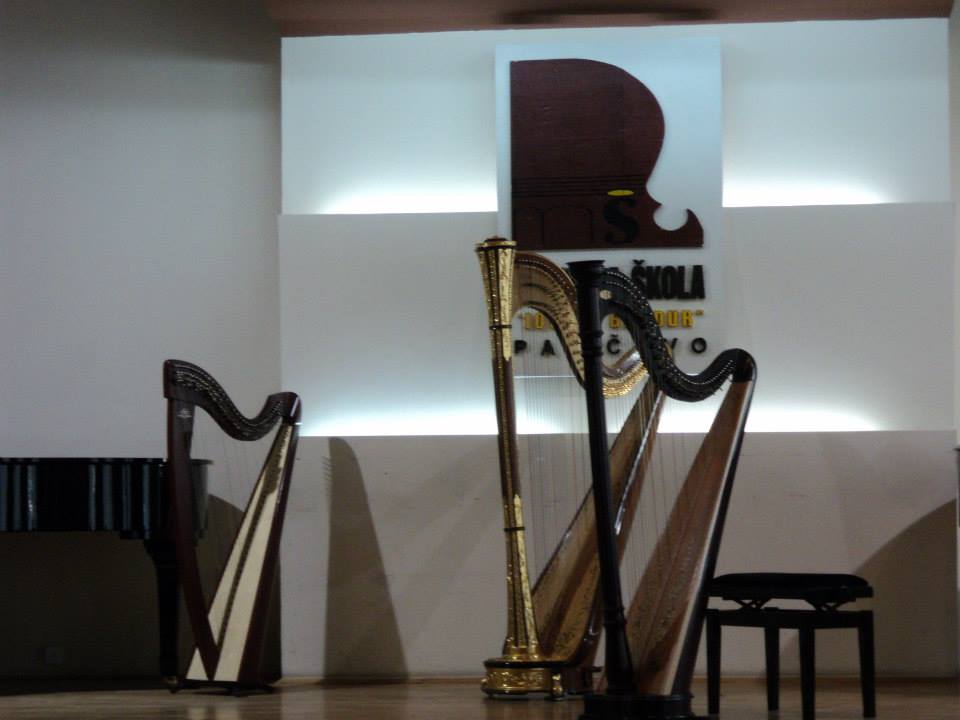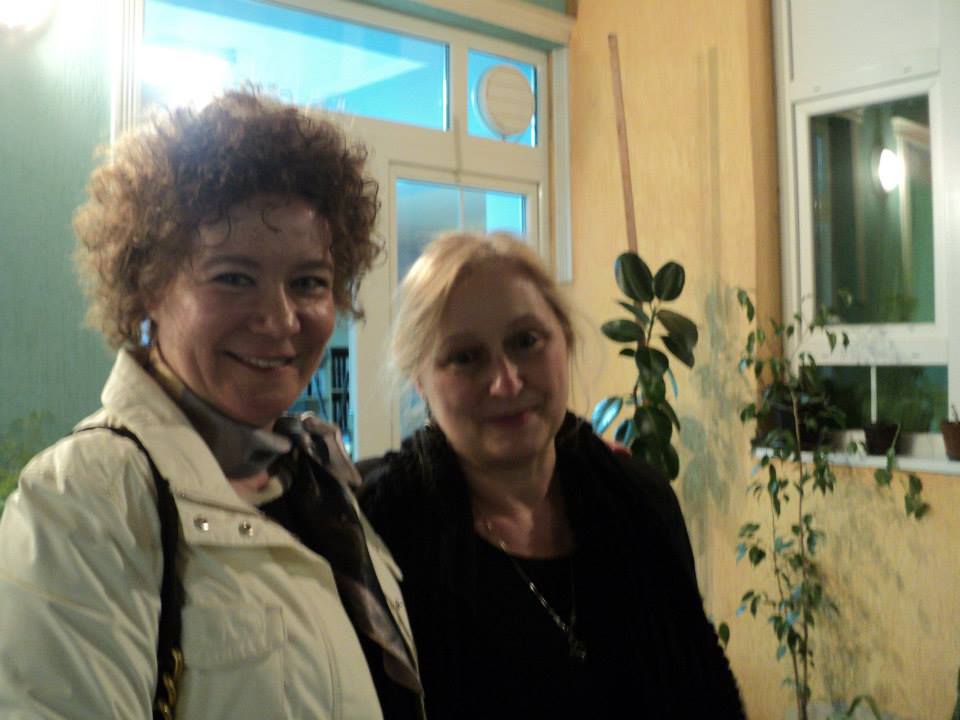L’Associazione Italiana dell’Arpa è onorata di avere creato una collaborazione e una partnership con una prestigiosa Accademia dalla quale provengono arpisti come Nadja Dornik, vincitrice del 1° premio nella scorsa edizione del Concorso Internazionale “Suoni d’Arpa”.
Fondata il 21 settembre 1899 con il nome di Serbian Music School, l’Accademia Mokranjac di Belgrado (così nominata nel 1946) è la più antica e prestigiosa istituzione musicale serba. Stevan Stojanovič Mokranjac, compositore, direttore di coro, pedagogo, studioso della musica tradizionale e sacra del suo paese, fu uno dei fondatori e la diresse fino al 29 settembre 1914.
L’Accademia attualmente presenta un’offerta formativa molto vasta e comprende un dipartimento di etnomusicologia. L’insegnante di arpa è Dijana Sretenović e la classe è formata da dodici allievi.
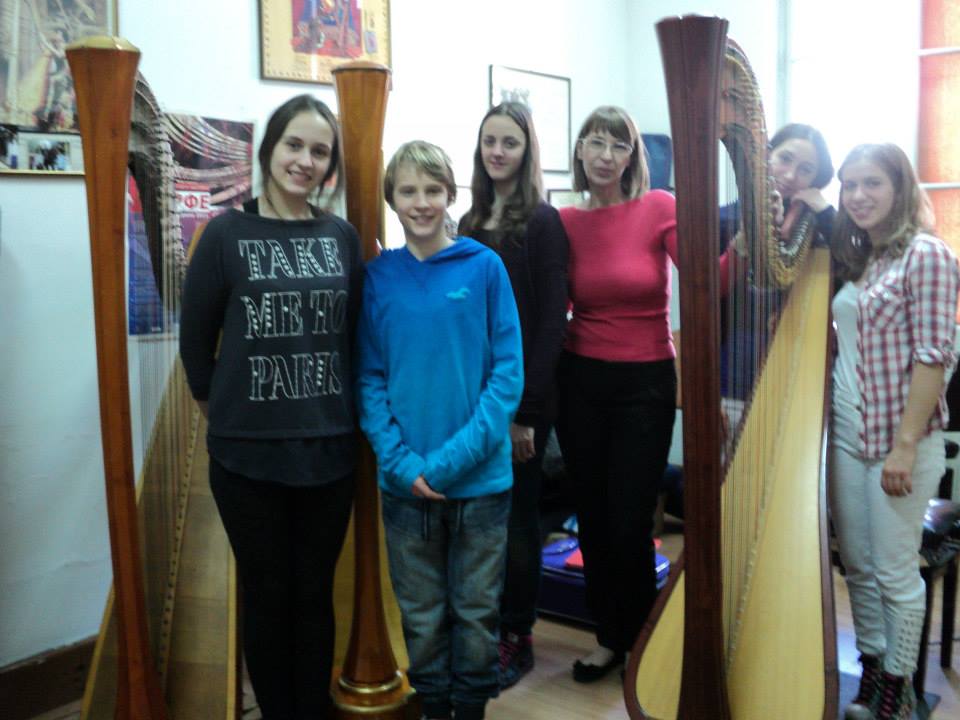 Dijana Sretenović insieme ad alcuni suoi allievi nell’aula di arpa
Dijana Sretenović insieme ad alcuni suoi allievi nell’aula di arpa
L’ammissione al corso di arpa è aperta ai ragazzi di età compresa tra i 7 e i 9 anni, ma sono attivi anche corsi preparatori per bambini fino ai sette anni di età. In questi corsi preparatori, che prevedono una frequenza di due giorni settimanali, i bambini scoprono il mondo della musica attraverso il canto e la conoscenza degli strumenti musicali in una forma ludica che esprimono anche attraverso il disegno. Lo studio del solfeggio, della teoria e la scelta dello strumento principale avviene dopo i sette anni di età per quanto concerne l’arpa, e ciò è concesso solo agli allievi che dimostrano di avere un effettivo talento naturale. Il primo periodo di studi, dopo i corsi preparatori, è di sei anni e comprende varie discipline, tra le quali l’orchestra, il coro e la musica da camera. Lo studio del pianoforte è obbligatorio. Segue un livello superiore della durata di quattro anni. Allo studio della musica, si affianca fin dal principio la scuola da noi definita come scuola dell’obbligo, che comprende anche lo studio delle lingue straniere e che si svolge all’interno dell’accademia stessa. La struttura dei corsi non è rigida e a chi dimostra interesse per uno strumento diverso da quello scelto, viene concesso di frequentare le lezioni di più strumenti. Nella classe di arpa ci sono due arpe russe di proprietà dell’accademia e un’arpa Dafne Salvi di proprietà dell’insegnante (la sua unica arpa). Gli allievi seguono turni di studio, dalle 6 del mattino fino alle 10 di sera, perchè nessuno di loro, inclusa Nadja, possiede lo strumento. Il livello di preparazione, anche dei più piccoli, è eccellente. La tecnica che riescono ad acquisire anche solo dopo un anno di studio è impressionante (Sonate di Naderman eseguite con la massima disinvoltura e precisione). Credo che in linea generale ciò dipenda da molti fattori : talento naturale, passione, forte motivazione, disciplina e studio come regola di vita, quindi non vissuto come una imposizione, ma come una naturale condizione esistenziale e soprattutto come una scelta responsabile. Ho tenuto una master class presso l’ Accademia Mokranjac e ascoltato arpisti pronti ad affrontare i principali concorsi internazionali, inoltre ho effettuato lezioni presso la “Jovan Bandur Music School” di Pančevo dove è attiva una classe di arpa formata da numerosi allievi seguiti dalla docente Milica Milivojevič.
A Pančevo ha avuto luogo la “Republic Competition for Music School Students from Serbia” alla quale hanno partecipato ventinove arpisti delle varie scuole musicali della Serbia, divisi in cinque categorie.
Il primo premio assoluto, con punteggio 100/100 (unanimità) è stato assegnato anche in quella sede a Nadja Dornik, allieva di Dijana Sretenović alla Accademia Mokranjac , che si è presentata nell’ultima categoria, pur essendo nata il 21 giugno 2000. Nadja ha eseguito magistralmente : Sonata in fa minore di J.B.Cardon, Fantasia di Camille Saint-Saens, Childreen at play di Marcel Grandjany e Danza Spagnola da “La vida Breve” di Manuel de Falla.
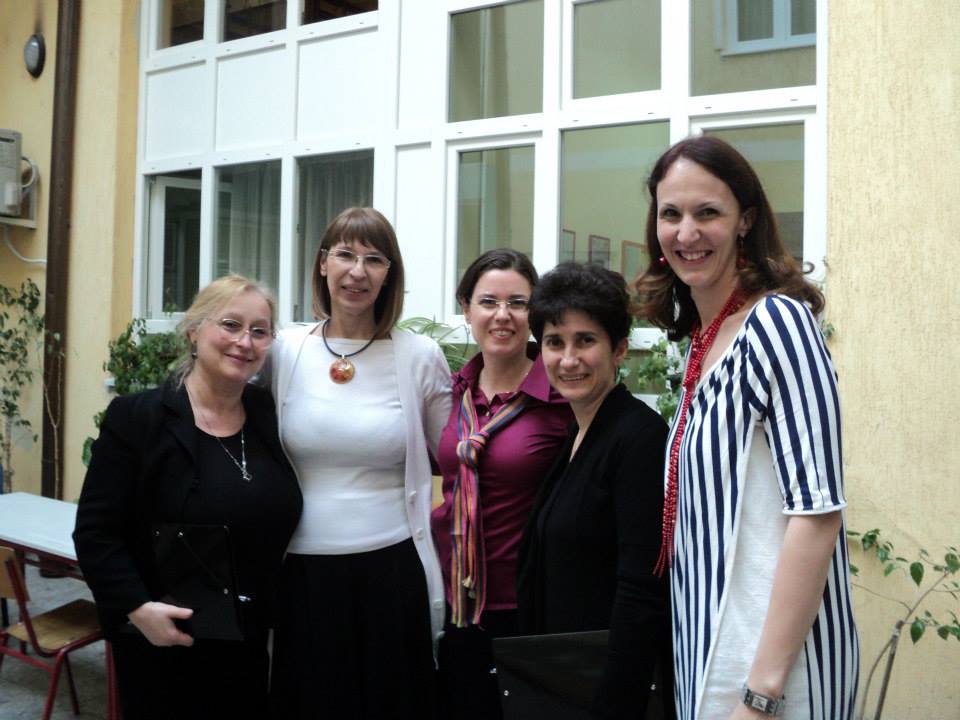 Da sinistra: Emanuela Degli Esposti (membro della giuria), Dijana Sretenović, Șirin Pancaroǧlu (membro della giuria e fondatrice dell’Associazione dell’Arpa Turca), Kohi Andonyan (membro della giuria e docente al Conservatorio di Sofia) e Milica Milivojevič
Da sinistra: Emanuela Degli Esposti (membro della giuria), Dijana Sretenović, Șirin Pancaroǧlu (membro della giuria e fondatrice dell’Associazione dell’Arpa Turca), Kohi Andonyan (membro della giuria e docente al Conservatorio di Sofia) e Milica Milivojevič
Stasa Mirkovic Grujic, docente di arpa al Conservatorio K.Stankovic di Belgrado e alla National Academy di Novi Sad. Alcune sue allieve parteciperanno al nostro prossimo Concorso.
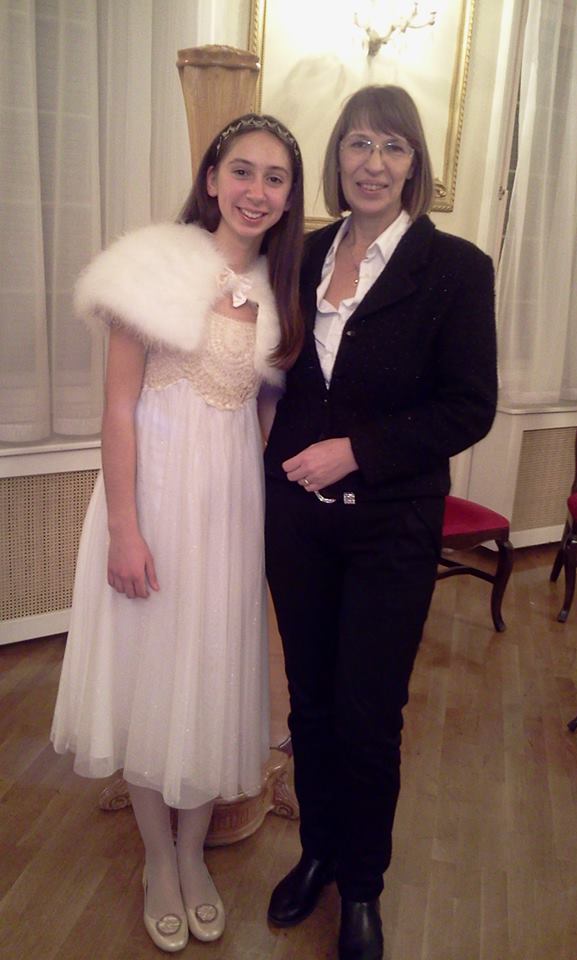 Nadja Dornik insieme alla sua insegnante Dijana Sretenović
Nadja Dornik insieme alla sua insegnante Dijana Sretenović
Nadja ha conseguito altri premi importanti, anche come pianista , e attualmente sta preparando il concorso Lily Laskine e i concerti premio che terrà alla Carnegie Hall di New York il prossimo 24 maggio all’arpa e il 26 maggio al pianoforte. Oltre ad essere nostra ospite d’onore a Villa Medici Giulini in occasione della prossima edizione di “Suoni d’Arpa”, Nadja Dornik terrà un recital il 3 luglio a Villa di Vico (Scandicci, Firenze). A tal proposito l’Associazione Italiana dell’Arpa ringrazia il direttore artistico M° Daniele Garella che ha voluto inaugurare la stagione di concerti dedicata al nostro strumento con un omaggio a questa straordinaria, giovanissima interprete. Ringraziamo anche l’arpista fiorentina Elena Castini per aver reso disponibile la sua arpa per il concerto. Ecco alcuni link dove è possibile ascoltare dal vivo Nadja Dornik, a cui farà seguito una presentazione dettagliata in lingua inglese dell’ Accademia Mokranjac di Belgrado.
Nadja Dornik al concerto dei premiati al Concorso Internazionale Suoni d’Arpa 2013
https://www.youtube.com/watch?v=O20BkqRxSbw
Concerto di Haendel (Grandjany)
https://www.youtube.com/watch?v=vqjA01-2ZeM&feature=youtu.be
Studio in La minore Schumann-Paganini
https://www.youtube.com/watch?v=NHgT51_iA18&feature=share
M.Glinka /Variazioni su un tema di Mozart
https://www.youtube.com/watch?v=IQ6U4rwwPbM&feature=youtu.be
Szeged Harp Competition
B. Bartók: An evening in the village, B. Cardon: Sonata in f minor, F. Godefroid: Etude de Concert in E flat minor
A. Khachaturian: Danse Oriental et Toccata
https://www.youtube.com/watch?v=ITiBuicPOlI
Nadja Dornik, harp – AWARD FOR ARTISTIC IMPRESSION and GOLDEN PLAQUETTE
M.Grandjany : Children at play,A.Khachaturian Oriental dance and toccata,
International Slovenian harp competition
https://www.youtube.com/watch?v=DQmbJZQrOZE&feature=share
Music School Mokranjac was founded in Belgrade on 21st September,1899. It was called Serbian Music School.It was the first and the only Music school in Serbia of that time. Today it is our oldest musical and educational institution which has a very important role for the development of musical and cultural education in our country. The School was founded by Belgrade Singing Society. It was one of the most important cultural institutions in Serbia in the second half of XIX century. Stevan Mokranjac, Stanislav Binički and Cvetko Manojlović were elected as the members of the Board of the School. The first headmaster of Serbian Music School was Stevan Stojanović Mokranjac and he did that job until he died on 29th September, 1914. In the beginning there were four teachers: Stevan Mokranjac- theoretical subjects, Stanislav Binički- theoretical subjects and solo singing, Cvetko Manojlović- the piano, Jovan Ružička- the violin. Later they were joined by Jovan Zorko- the violin, Emil Saks, the violin, Vićeslav Rendla, the cello, the double bass, the flute, Milan Buzina, the oboe and the clarinet, Petar Konjović, history of music and the head of the chamber ensemble, as well as the former students after they had come back from studying abroad: Jelena Dokić, the piano, Stevan Hristić, Ivanka and Miloje Milojević, Jovan Mokranjac, etc. During the wartime (1914-1918) the School almost stopped to work. At occupiers` demand the School changed its name into Belgrade Music School. Petar Krstić became the headmaster of the School after Stevan Mokranjac`s death. Between the two Wars the School became more and more eminent and music education and public music performances were more popular. Therefore the students and the teachers organized concerts more frequently and the audience was bigger and bigger. The School got its old name back- Serbian Music School, and Jovan Zorko became the headmaster instead of Petar Krstić. He did that job until he died in 1942. While getting more students, the School was getting more teachers of instrumental and theoretical department. Some of them were: Kosta Manojlović (1919), Josip Slavenski (1924), Mihovil Logar (1927), Jovan Bandur (1931), Predrag Milošević (1932), Ljubica Marić (1939), Svetolik Pašćan (1940), Ćiril Ličar (1925), Ruža Vinaver (1927), Olga Mihailović (1931), Aleksej Butakov (1937), Božena Bandur, Jela Kršić (1940), Marija Mihailović (1931) and the others. During the whole period between the two Wars, the teachers were very active as Belgrade performers and composers, although they were in bad financial situation working in inadeaqute conditions.The first concerts, music critics and music reference books were organized by the teachers of this school. The first postwar year, 1946, when the headmaster was Aleksej Butakov, is particularly important for the School. The School got the name after one of its founders, Mokranjac, and it has borne that name until today. The celebration of getting the new name was one of the most important manifestations which the School had in the postwar period. The date, 28th March (1946), when the Ministry approved the change of the name, is celebrated today as the Shool Day. However, the biggest problem of the School was its inadequate place. Its very eminent headmasters could not completely solve this problem in the postwar period, during the 1960`s. In 1961, when the headmaster was Božena Bandur, the School got more space on the ground floor of The Female Dormitory in 8 Proleterskih brigada (Krunska) street. It started to work in two buildings (besides the rooms in 21 Kneza Miloša street). It was a good solution for the educational quality, but there were problems with string and wind instrumental departments. At that time the School had many concerts with its choir and orchestral ensembles. In 1967, when the headmaster was Professor Slobodan Petrović, the School got II floor in the building in Krunska street. So far it has been the part of the School- for the srtring, wind instrumental departments and general education. In 1993, when the headmaster was Aleksandar Krastavčević, the part of the School from 8 Proleterskih brigada (Krunska) street and Kneza Miloša street was moved in the new building in 6 Dečanska street. The piano, solo singing and theoretical departments were moved there. It was then when Music Scool Mokranjac got its first big and nice concert hall. In 1974, the School celebrated its 75th anniversary of its existence with the presence of the most eminent people who were at the head of the state. Commemorative volume of the School was published then. It was the first bigger edition where the whole history, development and working results were collected in one place. Professor Branka Radović introduced important changes in educational organization in September,1995. Ethnomusicology department was opened then. Its aim was to revive Serbian folklore music. From shool year 1997/1998 Chamber Music Department was opened, too. Therefore chamber music was separated from the other vocal and instrumental departments. The School was still situated at two locations when it celebratd its first 100th anniversary of its existence. The celebration was organized in the united manifestations of its work. The first Commemorative Volume of 100 Years was published then. It describes the Shool as “the institution of prolific, various, rich and long-term activities, which have naturallly been oriented to the public music life“. Developing together from the place where it started its work, the Scool had enormous contribution to the general culture of the country. Although it has not been the one of its kind for a long time, Music School MOKRANJAC is still one of the most important part of music education in our country. Its teachers and students prove it by their successful concerts, public performances, recordings and getting numerous prizes at many domestic and international competitions. For the extremely high standard of work as well as for the excellent artistic and educational results, Music School “Mokranjac“ is awarded with the high public awards such as: the award Dositej Obradović (1969), Vuk`s Award and The Decoration of the Contribution to the People with the Gold Medal on the occasion of 75th anniversary of the foundation and working of the School (1974) and The Republic Award 25th May (1984). Many teachers and students of the School are also the winners of the important awards and acknowledgements of the social importance. School Council of Belgrade Music School
Stevan Stojanović Mokranjac`s Biography
Stevan Stojanović Mokranjac, after whom the School is named today, is one of the most important persons in Serbia at the end of XIX and the beginning of XX century. He was a composer, director of a choir, pedagogue, chamber musician, melograph of secular and spiritual music, writer of the studies of folklore and spiritual music and one of the founders of the first music school in Serbia-Serbian Music School.
He was born in Negotin on January 9th, 1856. While he was attending primary school there, he was also playing the violin as a self-taught child. He was attending Secondary school in Zaječar and Belgrade. He was also taught by private music teachers: K. Rešo ( the violin) and A. Cimbarić (singing).
In the middle of the seventies he became a member of Belgrade Singing Society, and after finishing Secondary school, in 1874, he enrolled Marthematics at Belgrade High School -Natural Science department, influenced by Svetozar Marković. However, thanks to Belgrade SigingSociety, he got state scholarship to study music abroad. First he went to Munich (where he studied composing at J. Reinberger, 1879-83). Because of financial and other difficulties he could not finish the studies. He went back to Belgrade and became the directot of a singing society “Kornelije“ where he composed his I Rukovet, collection of songs, ( just for the male choir in the original version). In 1884, he got six-month scholarship for Rome where he privately studied vocal poliphony of Palestrina`s style at A. Parisotti. Next year he continued his music education at the Conservatory in Leipzig (1885-1887). He attended theoretical department at S. Jadassohn) and K. Reinecke and he also attended conducting at A. Brodski.
From 1887 Mokranjac was constantly connected to Belgrade, at first as a director of Belgrade Singing Society- he wrote all of his rukoveti for it except the first one. He played them at many concerts and tours in the country and abroad from 1893-1911: Dubrovnik, Montenegro (Kotor, Cetinje), Thessaloniki, Skopje, Budapest, Turkey (Istanbul), Bulgaria (Sofia, Plovdiv), Russia (Petrograd, Njižni Novogord, Moscow, Kiev), Germany (Berlin, Dresden, Leipzig), Sarajevo, Split, Cetinje, Trieste, Rijeka, Zagreb.
From 1887 to 1900 he worked as a teacher of singing in First Belgrade High School, and he taught church chanting in Bogoslovija from 1901.
He was the founder of the first string quartet in Serbia- Serbian String Quartet where he played the second violin besides Ferdinand Melher (the first violin), Stevan Šram (the viola) and Josif Svoboda (the cello) who had concerts from 1889-1893.
In 1899, together with Cvetko Manojlović and Stanislav Binički, Mokranjac founded the first constant music school in Belgrade- Serbian Music school (today Music School “Mokranjac“). The School was supported by Belgrade Music Society. Mokranjac was the headmaster and he taught almost all of the theoretical subjects until his death in 1914.
For 15 years he was continually involved in melographic work of the spiritual music (1897-1912): he wrote down the so-called Belgrade Church Chanting. He also editted Osmoglasnik for learning of church chanting, and he collected the other spiritual melodies in the collection Strano pjenije (Foreign singing) which was lost during World War I.
Mokranjac was also writing down and collected Serbian folk melodies on the territories of Serbia, Macedonia (Old Serbia), Kosovo and Metohija and he left 460 folk works- 381 songs are saved among them. Especially important is the collection Folk songs and plays with the Melodies from Levč. It was published in 1902, and thanks to its preface, it became the first important scientific study about our folklore.
In 1906 Mokranjac was elected as a corresponding member of The Serbian Royal Academy. In 1911 he became corresponding member of French Music Academy.
He was also the first president of the Serbian Music Society founded in 1907.
Exhausted by work and many duties, he died on September 29th ,1914. He died in Skopje while he was retreating with Serbian people at the beginning of World War I.
Stevan Mokranjac`s work was founded exclusively on choir (a capella) music of secular and spiritual contents with a very few numbers of instrumental works (Five fugues for string players, scene music for Ivkova Slava) and a few solo songs for voice and the piano ( ballads Led Edim, Three Heroes and Winter Day as the last written work).
Rukoveti are the most important part of his opus. They are choir rhapsodies consisting of numerous songs which Mokranjac prepared musically by carefully paying attention to the text style, melodies, harmonies, forms, choir movements. He applied various procedures by using the principle of contrast in the character, tempo,structure…like in all cycle forms.
Mokranjac wrote 15 Rukoveti from 1883-1909 using 90 songs of various characters and origin. Melodies from Serbia, From My Homeland belong to I, II, III, IV (Mirjano), V, VI (Hajduk Veljko), XIII Rukovet, From The Old Serbia belong to VIII, XI, From Kosovo to XIII, XII Rukovet, From Ohrid to X, From Macedonia to XV, From Montenegro to IX, From Bosnia to XIV one. Seaside melodies with the songs from Dalmatia are very similar to the rukoveti by their structure. They are considered to be Mokranjac`s XVI rukovet.
Kozar (1904, f-minor) belongs to secular music. It is a choir miniature- a choir scherzo which represents Mokranjac`s work of the highest original folk quality.
His works in Spiritual Music were written in orthodox tradition and they are equally important in Mokranjac`s works. These are works of high quality: Requiem fis-minor, Liturgy of St. Jovan Zlatousti, Two Songs on Good Friday, Akatist, I praise You God, Three statije, on Good Saturday, etc.
His compositions present the cultural and music inheritance of our country, and, at the same time, they are obligatory parts of everyday music performance and inspiration for younger musicians.
Former Students and Teachers
Music Shool “Mokranjuac” is the oldest Serbian musical and educational institution and it represents the foundation of the musical culture and education in Serbia. Many important people from the world of music went through this school both as teachers and students- such people as composers, performers, musicologists and pedagogues from almost all the parts of the former Yugoslavia. Concert and opera life, orchestras and chamber ensembles, other institutions and universities, musical editorial offices for radio and television- all those came from the work of the first Serbian Music School. Among the eminent authors whose names are connected to the School and who worked as the teachers besides Stevan Mokranjac in the first decades of XX century, the distinguished places belong to the composers: Petar Konjović, Miloje Milojevic, Stevan Hristić, Kosta Manojlović, Mihovil Logar, Joip Slavenski, Ljubica Marić, Predrag Milošević, and in the second half of the century: Konstantin Babić, Dejan Despić, Zoran Erić…
Chronologically…
In the first school year (1899/1900) there were 48 students taught by four teachers: Stevan Mokranjac (theoretical subjects), Stanislav Binički (theory and solo singing), Cvetko Manojlović (the piano) and Jovan Ružička (the violin); he was of a Czech origin. In the next school year the School got the cello and employed Vićeslav Rendl, who was also of Czech origin, as the teacher of the instrument. For many years later he was teaching the double bass and the flute, he was also the conductor and the leader of chamber ensembles.
From 1909 there were more and more teachers employed because there were much more students. Besides the people mentioned above, there were other important teachers: Nina Šopović, Rajna Dimitrijević and Danica Krstić, the piano teachers; Jovan Zorko, the violin, Emil Saks, (of the Czech origin), the violin, Milan Buzina, the oboe and the clarinet, Petar Konjović, history of music and the head of chamber ensemble, and the former students became teachers after they had come back from studying abroad.
At that time, at the beginning of XX century, the famous students of the School were Ruža Šafarik (the piano player who later became the teacher), Petar Ilić (composer- the first finished student of The Serbian Music School), Stevan Hristić, Miloje Milojević, Ivanka Milutinović (the piano player who later became Miloje Milojević`s wife and the teacher), Jovan Mokranjac (the bass player, later the teacher); he was a nephew of Stevan Mokranjac.
In every new school year until the World War I, there were some distinguished students who later became very important people in the world of culture and science: Stanislav Vinaver (writer, music critic, and essay writer), Margita Nušić (Branislav Nušić`s daughter), Ksenija Atanasijević (philosopher), Moša pijade, Marko Čelebonović (painter), Pavle Vasić (painting historian), Aleksandar Vučo (writer), and many University professors and doctors.
In the period between the Wars, the following students finished the School: Branko Dragutinović (music critic), Stana Đurić, later Klajn (musicologist and the professor of Music Academy in Belgrade), Miodrag Vasiljević (ethnomusicologist and the professor of Music Academy), Olga Mihailović (the piano player and the professor of Music Academy), Ljubica Marić (composer), Stanojlo Rajičić (composer), Lazar Marjanović and Vladimir Marković (the professors of the violin at Music Academy), Vojislav Ilić (conductor) and many others.
There were also some people who spent a short time in the School: Mihajlo Vukdragović, Milan Ristić, Dragutin Čolić, Aleksandar Obradović (composers), Dragutin Gostuški (musicologist, the director of the Musicology Institute SANU), Dušan Plavša (music writer), Borivoje Simić (conductor), Bahrija Nuri-Hadžić (solo singer), Lujo Davičo (ballet dancer and pedagogue), Oskar Davičo (writer), Renata Ulmanski (actress)…
After World War II there were many distinguished musicians who had been the students of the School: composer Rajko Maksimović (the professor at Belgrade Music Academy), Vuk Kulenović, Ivan Jevtić, musicologist Mirjana Hofman-Veselinović, PhD (the professor at Belgrade Music Academy), Sonja Marinković, PhD (the professor at Belgrade Music Academy), Dubravka Jovičić, PhD, the dean at Belgrade Music Academy). Some solo performers who had attended the school “Mokranjac” became internationally popular: the piano player Ivan Tasovac (today the director of Belgrade Philharmonic Orchestra), the violin player Vesna Stanković (concert master of Vienna Chamber Orchestra and the member of the European Chamber Orchestra), the cello player Ksenija Janković, opera singer Milena Kitić and Irena Zarić, the harpsichord player Smiljka Isaković. Besides them, there are the other former students of the School who are very popular: Vasil Hadžimanov, stage performer, Mina Lazarević, actress, Jelena Galonić- stage performer…
T
PRIMARY MUSIC SCHOOL
ADMISSION REQUIREMENTS
The students of various ages are enrolled in the first class of Primary Music School in accordance with the law of System of Education. The school lasts depending on the instrument which they would like to play at the entrance exam.
The student is prepared to get admitted at school if he/she passes the entrance exam, which includes psychological testing controlled by the school psychologist and the checking of musical abilities which is controlled by the board consisting of the teachers of the school.
In the first class of nowadays six-year music school, the students between the ages of 7-9 can get enrolled for the following instruments: the piano, the harp, the guitar, the flute, the violin, the cello.
The students between 9 and 12 can be enrolled in the first class of four-year primary music school for the following instruments: the oboe, the clarinet, the bassoon, the horn, the trumpet, the trombone, the double bass, the flute, the caval, the gusle.
Students between 10 and 20 can be enrolled in the first class of two-year education at solo singing and traditional folk singing departments.
Preparatory Class
The children under 7 years old who pass the entrance exam can be enrolled in the preparatory class. During the school year the attendants have 2 classes per week. They learn children`s songs, games, get introduced to musical instruments, listen to music and explain what they hear (by drawing pictures and illustrations). Thus they get interested in music. This is an entertaining and educational way to get them prepared for taking the entrance exam for primary music school. Solfeggio and instrument classes are organized for the most talented children in the second term.
THE LASTING OF EDUCATION
Primary music school enables students learning to play numerous instruments:
During six-year education the following instruments are learned to play:
the piano, the harp, the guitar, the flute,
the violin, the cello
During four-year education the following instruments are learned to play:
the double bass, the oboe, the clarinet, the bassoon
the horn, the trumpet, the trombone,
the flute, the caval, the gusle
Two-year education is needed for learning:
solo-singing,
traditional folk singing
Besides the instruments, solo-singing and traditional singing as the main subjects, the students attend a few more subjects:
solfeggio,
the theory of music,
chamber music,
small choir (the students of the piano, the harp, the guitar from IV-VI class)
small orchestra (the students of string and wind instrument departments)
SECONDARY MUSIC SCHOOL
SPECIAL DEPARTMENTS
Secondary music school lasts four years and the students are enrolled at three departments:
1. Vocal and instrumental
2. Theoretical
3. Ethnomusicology
Vocal and instrumental department is divided into four boards:
1. The piano and the harp
2. String instruments- the violin, the viola, the cello, the double bass
3. Wind instruments: the flute, the oboe, the clarinet, the bassoon, the horn, the trumpet, the trombone
4. Board for solo-singing
The guitar belongs to the board of chamber music.
Main subjects at theoretical department are solfeggio and harmony.
Traditional folk singing or playing is learned at ethnomusicology department.
Besides the main subject (the instrument, solo/ethno singing, solfeggio), the obligatory instrument is the piano for all the departments except the piano one. The students who had finished learning to play some other instrument during their previous education learn to play the piano according to the programme of primary school. The students who had finished learning to play the piano in primary school continue learning to play the piano according to the programme of parallel piano for secondary school.
Special subjects at vocal and instrumental department consist of: chamber music, reading from the list, corepetition (for the piano students), orchestra (for the string and wind instruments students), choir (for solo-singers, harpists and guitar players), group singing, folk play and ethnology (at ethnomusiclology department).
The other music and theoretical subjects are mutual for all the departments- solfeggio, harmony, counterpoint, musical forms, history of music, national history of music, musical instruments, ethnomusicology.
Students can also attend general education in secondary music school. The subjects are adjusted to the students.
Students are educated at two locations: in the building in 6 Dečanska street and in 8 Krunska street. Administration of the School, departments for the harp, solo singing and theoretical department are situated in 6 Dečanska street. The departments for the string and wind instruments, ethnomusicology, chamber music, the guitar and general education are situated in 8 Krunska street.
GENERAL EDUCATION
Besides music education, students of Music School “Mokranjac” are enabled to get general education at the department for general education. The programme of the department is adjusted to the needs of the students of music school. The subjects mostly belong to the social ones, except biology and physics which are taught in the first class. The students also choose two optional subjects at the beginning of the first class- religious education and civic rights.
Besides Serbian language and literature, the students also learn foreign languages (English, French, German, Italian). If a student had learned just one foreign language in primary school, he chooses to learn another foreign language (Italian or French).
According to the programme, psychology and philosophy are enriched with topics needed for music, esthetics and the students also have the chance to develop critic and abstract thinking.
History of civilization and sociology enable students to understand the development of society and the importance of culture, civilization, kinds of cultural differences in society nowadays.
The teachers contribute to better and much more modern education by attending teacher training courses, applying the adequate literature. Therefore the programme is easier and more interesting for the students.
